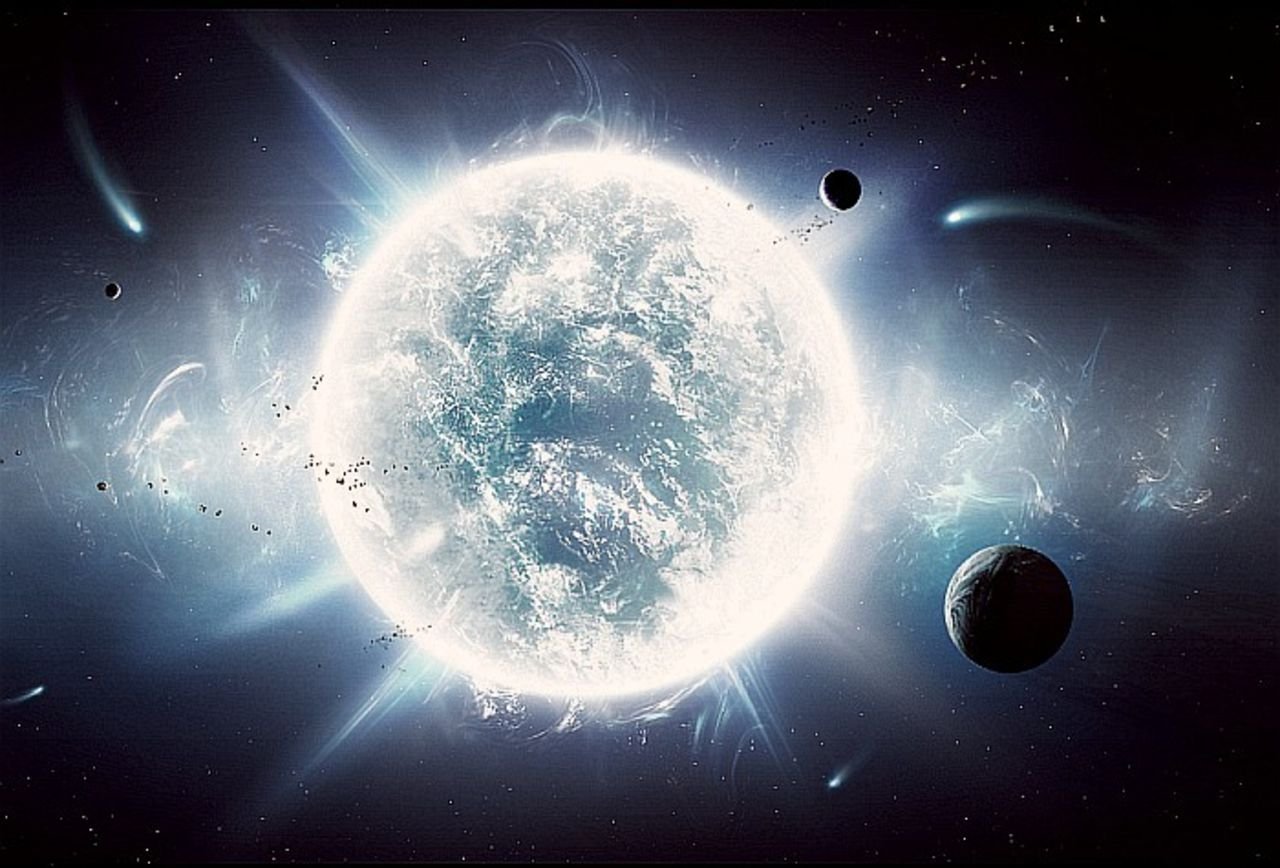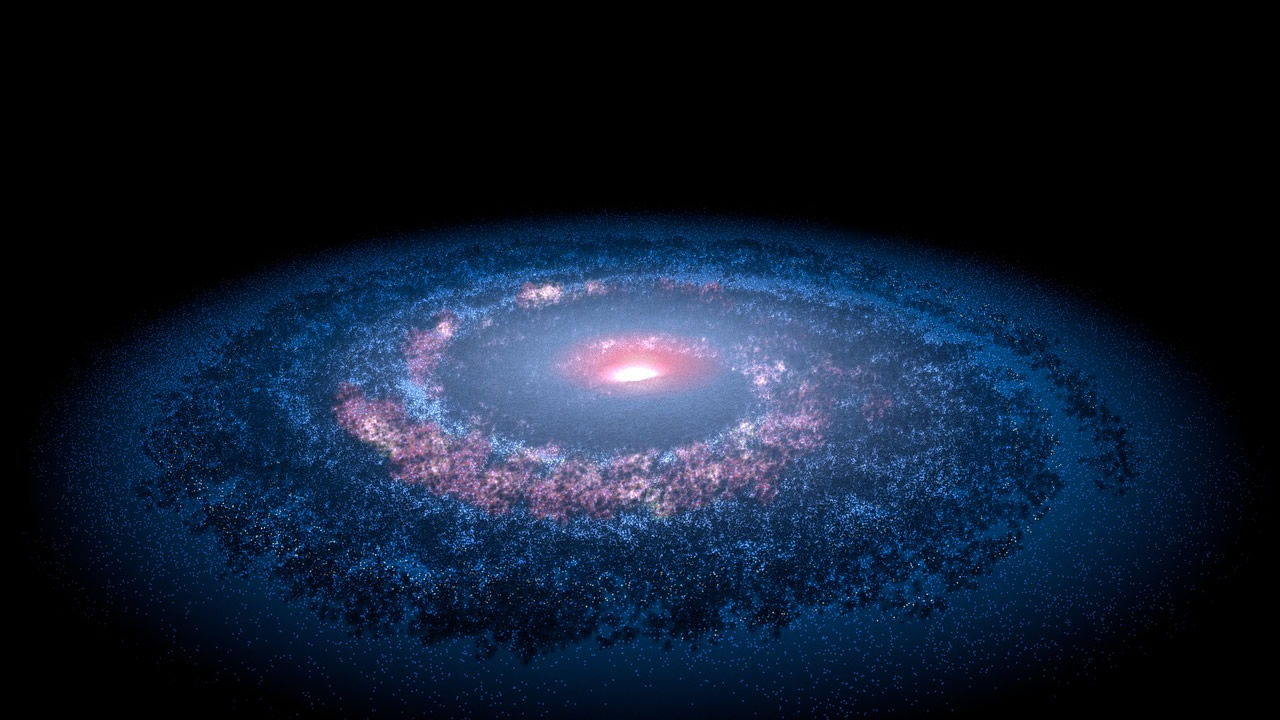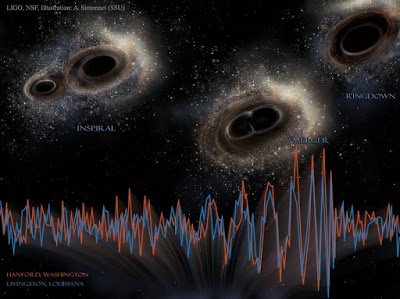
Black holes are active phenomena in space, many people have given to the task, trying to explain or understand more depth everything that refers to them, how are they? what is inside? Where are the stars or planets that have been swallowed by them going to stop? and a number of questions that cause the fact of thinking about their shapes and what at first sight is seen, but ultimately it is not something so simple explain.
If we look in the encyclopedia, we would read that a black hole is "a finite region of space inside which there is a mass concentration high enough to generate that gravitational field that nothing, not even light, can escape".
But what does this mean and why does it happen? To understand it, let's start with a star. The nearest and best known is the example of the Sun. Our Sun has a diameter of 1,392,500 kilometers and a mass 330,000 times greater than that of Earth. If it were possible, any object on the surface of the Sun, a robot, that poor robot would once be 28 times larger than the Earth's surface.

A star retains its stable size because the temperature of its center tends to expand and its severity tends to contract. That is, the size of the Sun is the result of the forces that fight and balance each other. While its temperature and its gravity are contrary, the Sun, taking in the same diameter.
When a star begins to age, the temperature inside it gradually decreases. Therefore, gravity becomes the dominant force and begins to win. Logical, right? Then the star contracts more and more. It contracts so much that the atomic structure of its interior disintegrates: instead of so many protons, neutrons and loose electrons remain. The contraction goes on and on until the loose electrons repel each other. This is how the star becomes a "white dwarf". If our Sun collapses to put it back in a white, all its mass will be concentrated in a sphere of 16,000 kilometers in diameter and its surface gravity would be 210,000 times larger than that of Earth.

Now imagine that the electrons do not reach to counteract the gravity and the star continues to contract. Sooner or later, the electrons and protons combine to form neutrons that clump together, managing to stop the contraction. The result is a "neutron star". If our Sun becomes a neutron star, its entire mass could be in a sphere only 16 kilometers in diameter, with a surface 210,000,000,000 times more than Earth!

Under certain conditions, gravitation can overcome even the resistance of the neutron structure. In that case, there is nothing that can oppose the collapse. The star can contract to a zero volume and the surface gravity increase to infinity.
According to the theory of relativity, the light emitted by a star loses some of its energy as it advances against the gravitational field of the star. The more intense the field, the greater the loss of energy, which has been experimentally verified in space and in the laboratory.
The light emitted by an ordinary star like the Sun loses very little energy. The one emitted by a white dwarf, something else; and that emitted by a neutron star even more. Throughout the process of collapse of the neutron star there comes a time when the light emanating from the surface loses all its energy and cannot escape.
An object subjected to a compression greater than that of the neutron stars would have a gravitational field so intense that anything that approached it would be trapped and could not come out again. It is as if the trapped object had fallen into an infinitely deep hole and never stopped falling. And since even light can not escape, the compressed object will be black. Literally, a "black hole."
Classification of Black Holes
Black holes, according to their mass are classified into three types:
- Micro-Black Holes.
- Star Mass-holes
- Super Massive Holes.
-Micro-Black Holes.
The micro black holes are just a theory proposed by Professor Stephen Hawking. In this class of black holes, quantum mechanics play a very important role.
About this type of holes, I will only make a small approximation given the enormous difficulty of explaining this type of holes due, among other things, to its close relationship with quantum physics.
It has been predicted that primordial black holes or micro black holes are a product of the Big Bang. It is believed that innumerable black holes were formed due to the enormous amount of energy that was generated at the beginning of our Universe. However, it is thought that black holes do not live long. As black holes radiate energy, they will also lose mass (according to Stephen Hawking's theory, "Hawking radiation"), so small black holes will extinguish very quickly.
These black holes appeared (in theory) at the time of creation of the universe. They have created thanks to the high temperatures reached by the universe in the instants after its creation, but it is unlikely that these holes have existed to this day because they would have that have had a mass of 1,000,000,000,000 Kg.
Although it is possible that these holes continue to be created and disappearing in a short time. Moreover, in the particle accelerator of Switzerland, it is believed that this type of holes could be formed, although no one is alarmed because they would not have any effect on the earth.

- Star Mass-Holes.
A stellar black hole is a black hole formed by the gravitational collapse of a massive star (more than 8 solar masses) at the end of its lifetime. The process is observed as a supernova explosion or an explosion of gamma rays. This black hole is going to have a mass of more than 3 solar masses. The largest known black hole (up to 2001) has 14 solar masses.
Theoretically, there may be black holes of any mass (General Relativity). The less mass you have, the greater the density of matter must be to form a black hole, over the radius of a black hole). There are no known processes that can produce black holes with a mass smaller than a few times the mass of the Sun. If these exist, they are mainly primordial black holes.
The collapse of a star is a natural process that produces a black hole. It is inevitable that at the end of a star's life, when all-star energy sources are depleted if the mass of the star that is collapsing is under a certain critical value, the final product will be a compact star, be it a white dwarf, a neutron star or a quarks star. These stars have a maximum mass. So if the star that is collapsing has a mass that exceeds this limit, the collapse will continue forever (catastrophic gravitational collapse) and form a black hole. The maximum mass of a neutron star is still unknown, however, it is believed that it would be around 3 solar masses.

- Super Massive Holes.
A supermassive black hole is a black hole with a mass of the order of millions or billions of solar masses.
Scientific studies already support that the Milky Way has a supermassive black hole in the galactic center. It is believed that many, if not all, galaxies harbor a supermassive black hole at its center. In fact, one of the most widespread theories in recent times is to assume that all elliptical and spiral galaxies have a supermassive black hole at their center, which would generate enough gravity to maintain unity. A supermassive black hole has some interesting properties that differentiate it from others of lesser mass:
The average density of a supermassive black hole can be very low, in fact, it can be less than the density of water. This happens because the radius of the black hole increases linearly with the mass, so the density decays with the square of the mass.
The tidal forces in the vicinity of the Event Horizon are noticeably smaller. Since the center of the singularity is very far from the horizon, a hypothetical astronaut traveling towards the center of the black hole would not experience significant tidal forces until it penetrates much into the black hole.
Black holes of this size can be formed in only two ways: by a slow growth of matter (from a star size), or directly by external pressure in the first moments of the Big Bang. The first method requires a long period and large amounts of matter available for the growth of the black hole.
Doppler measurements of the matter that surrounds the nucleus of galaxies neighboring the Milky Way reveals a very fast rotating movement, which is only possible due to a large concentration of matter in the center. Currently, the only known object that can contain enough matter in such a small space is a black hole. In more distant active galaxies, it is thought that the width of the spectral lines is related to the mass of the black hole that generates the activity of the galaxy.
It is speculated that supermassive black holes at the center of many galaxies, would act as the "engines" of the same, causing their rotating movements, such as Seyfert galaxies and quasars. It is believed that Sagittarius A * is the central supermassive black hole of the Milky Way.
In May of 2004, Paolo Padovani and other astronomers announced the discovery of 30 supermassive black holes outside the Milky Way.

Data about a space explosion.
By September 2014, energy waves traveling for more than a billion years gently rocked space-time in the vicinity of Earth. This alteration, produced by the fusion of a pair of black holes was registered by the Laser Interferometer Gravitational Wave Observatory (LIGO). This event was the first detection of gravitational waves and opened a scientific window on how the universe works, NASA said.
Less than a second later, the Gamma Ray Monitor from NASA's Fermi Space Telescope found a brief, weak burst of high-energy light consistent with the same part of the sky. The analysis of these explosions suggests that there is only 0.25 of a chance for it to be a random coincidence. The elevation of Gamma rays from a fusion of black holes would be a milestone in space research because black holes are expected to fuse "cleanly", without producing any kind of light.

"This is a tempting discovery with little chance of being a false alarm, but before we can rewrite the books we will need to see more explosions associated with gravitational waves from black hole mergers," said Valerie Connaughton, a member of the Lightning Bolt Monitor. Gamma (GBM), who also led an investigation in The Astrophysical Journal.
Gravitation sensing light from a wave source will allow a deep understanding of the event. The Fermi Gamma-Ray Monitor looks at the entire sky not blocked by Earth and is sensitive to X-rays and Gamma rays with energies between 8,000 and 40 million electron-volts (eV). For comparison, the visible light energy varies between 2 and 3 eV.

With its wide range of energy and large field of vision, the GBM is a premier instrument for detecting light from short bursts of Gamma rays, lasting less than two seconds. It is believed that they occur when they orbit shared objects, such as neutron stars and black holes, spin spirally and collide together. It is suspected that these systems are the main producers of gravitational waves.
"With just one joint event, Gamma rays and gravitation waves together will tell us exactly what causes the short bursts of Gamma rays," said Lindy Blackburn, a collaborator with LIGO. "There is an incredible synergy between the two observations, with the Gamma rays revealing details about the energy source and crazy environment and gravitational waves that generate a unique test of the dynamics in this event," he explained according to NASA.
Currently, gravitation wave observations have a relatively blurred vision. This will improve over time as more facilities start to work.
Less than half a second after LIGO detected the gravitation waves, the GBM picked up a weak X-ray pulse, which lasted only a second. The explosion actually occurred under Fermi and at a high angle of the GBM detectors, a situation that limited the ability to establish an exact position. Fortunately, Earth blocked a blast from the explosion, allowing scientists to find the location.
It is believed that the event captured by the LIGO was caused by a fusion of relatively large black holes, each with a mass 30 times greater than that of the Sun. It was not believed that binary systems with such large black holes were common, and many remain questions about its nature and the origin of the system.
Black hole mergers were not expected to emit X-rays or Gamma rays because gas is needed to generate the light. It is believed that any gas around the black holes would have been absorbed before the final immersion. For this reason, some astronomers see the GBM explosion as a coincidence. Others have developed alternative scenarios where black holes could create Gamma-ray emissions. Future detections are needed to clarify what happens when black holes collide.

Albert Einstein predicted the existence of gravitation waves in his theory of relativity a century ago, and scientists have tried to detect them for 5 decades. Einstein visualized these waves as ripples in a space-time factory produced by massive acceleration bodies, such as the black holes orbiting each other. Scientists are interested in observing and characterizing these waves to learn more about the sources that produce it and about gravity itself.
Studying space, and the phenomena that exist in it is something totally exciting, knowing that there are so many things that we do not yet know, of that immense place, causes a feeling of helplessness, it seems, that a life is not enough to be able to decipher the mysteries, which houses, such a majestic place.
For more information visit this pages:
https://laprensa.peru.com/tecnologia-ciencia/noticia-que-son-agujeros-negros-nasa-fotos-video-72668
https://cmcarmarinacmartin.jimdo.com/clasificaci%C3%B3n-de-los-agujeros-negros/agujeros-negros-supermasivos/
http://www.muyinteresante.com.mx/junior/espacio/17/03/23/agujero-negro/
Thank you all for reading my publication.
saludos desde ya siguiendo y apoyando saludos mi pana
Downvoting a post can decrease pending rewards and make it less visible. Common reasons:
Submit
que lindo tenemos que apoyarnos... saludos
Downvoting a post can decrease pending rewards and make it less visible. Common reasons:
Submit
epa mi compa, gracias igualmente, un abrazo..
Downvoting a post can decrease pending rewards and make it less visible. Common reasons:
Submit
Good Post..
Downvoting a post can decrease pending rewards and make it less visible. Common reasons:
Submit
thanks, see you.
Downvoting a post can decrease pending rewards and make it less visible. Common reasons:
Submit
Votado ,seguido y apoyado hermano suerte ,buen post
Downvoting a post can decrease pending rewards and make it less visible. Common reasons:
Submit
Wow this is an interesting information. If I understood correctly, the black holes are part of the life of a star? It is the result of its core cooling and its collapse because its gravity no longer has temperature that keeps it in balance? I'm impressed! thanks for sharing. You have my vote
Downvoting a post can decrease pending rewards and make it less visible. Common reasons:
Submit
It is amazing to know that they are really black holes. I had always imagined that they were really a pass to another side but I already understand that they are a mass with such gravity that even light does not escape them. Upvoted!
Downvoting a post can decrease pending rewards and make it less visible. Common reasons:
Submit
tu blog me recuerda a las revistas "muy interesante" que coleccionaba de niño, excelente post
Downvoting a post can decrease pending rewards and make it less visible. Common reasons:
Submit
Hi, I liked your information
Downvoting a post can decrease pending rewards and make it less visible. Common reasons:
Submit